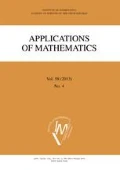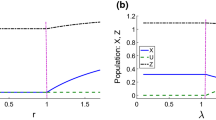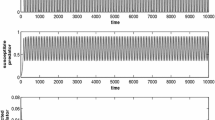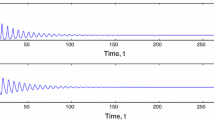Abstract
The paper deals with two mathematical models of predator-prey type where a transmissible disease spreads among the predator species only. The proposed models are analyzed and compared in order to assess the influence of hidden and explicit alternative resource for predator. The analysis shows boundedness as well as local stability and transcritical bifurcations for equilibria of systems. Numerical simulations support our theoretical analysis.
Similar content being viewed by others
References
K. Chakraborty, S. S. Das: Biological conservation of a prey-predator system incorporating constant prey refuge through provision of alternative food to predators: A theoretical study. Acta Biotheoretica 62 (2014), 183–205.
C. W. Clark: Mathematical Bioeconomics: The Optimal Management of Renewable Resources. Wiley-Interscience Publication, John Wiley & Sons, New York, 1990.
L. M. E. de Assis, M. Banerjee, E. Venturino: Comparing predator-prey models with hidden and explicit resources. Ann. Univ. Ferrara, Sez. VII, Sci. Mat. 64 (2018), 259–283.
L. M. E. de Assis, M. Banerjee, E.Venturino: Comparison of hidden and explicit resources in ecoepidemic models of predator-prey type. To appear in Comput. Appl. Math.
H. I. Freedman: Deterministic Mathematical Models in Population Ecology. Monographs and Textbooks in Pure and Applied Mathematics 57, Marcel Dekker, New York, 1980.
N. S. Goel, S. C. Maitra, E. W. Montroll: On the Volterra and other nonlinear models of interacting populations. Rev. Mod. Phys. 43 (1971), 231–276.
M. Haque, B. L. Li, M. S. Rahman, E. Venturino: Effect of a functional response-dependent prey refuge in a predator-prey model. Ecological Complexity 20 (2014), 248–256.
M. Haque, M. S. Rahman, E. Venturino: Comparing functional responses in predatorinfected eco-epidemics models. BioSystems 114 (2013), 98–117.
M. A. Hixon: Species diversity: Prey refuges modify the interactive effects of predation and competition. Theor. Popul. Biol. 39 (1991), 178–200.
A. J. Lotka: Contribution to the theory of periodic reactions. J. Phys. Chem. 14 (1910), 271–274.
A. J. Lotka: Analytical note on certain rhythmic relations in organic systems. Proc. Natl. Acad. Sci. USA 6 (1920), 410–415.
J. D. Murray: Mathematical Biology. Biomathematics 19, Springer, Berlin, 1989. MR
L. Perko: Differential Equations and Dynamical Systems. Texts in Applied Mathematics 7, Springer, New York, 2001.
E. Venturino: The influence of diseases on Lotka-Volterra systems. Rocky Mt. J. Math. 24 (1994), 381–402.
E. Venturino: Ecoepidemiology: a more comprehensive view of population interactions. Math. Model. Nat. Phenom. 11 (2016), 49–90.
V. Volterra: Variazioni e fluttuazioni del numero d’individui in specie animali conviventi. Memorie Acdad. d. L. Roma 2 (1927), 31–113. (In Italian.)
V. Volterra: Variations and fluctuations of the number of individuals in animal species living together. ICES Journal of Marine Science 3 (1928), 3–5.
Author information
Authors and Affiliations
Corresponding author
Additional information
Ezio Venturino acknowledges the partial support of the program “Metodi numerici nelle scienze applicate” of the Dipartimento di Matematica “Giuseppe Peano” and Luciana Mafalda Elias de Assis acknowledges the support of UNEMAT.
Rights and permissions
About this article
Cite this article
Assis, L., Banerjee, M., Cecconello, M. et al. Lotka-Volterra Type Predator-Prey Models: Comparison of Hidden and Explicit Resources with a Transmissible Disease in the Predator Species. Appl Math 63, 569–600 (2018). https://doi.org/10.21136/AM.2018.0158-18
Received:
Published:
Issue Date:
DOI: https://doi.org/10.21136/AM.2018.0158-18




